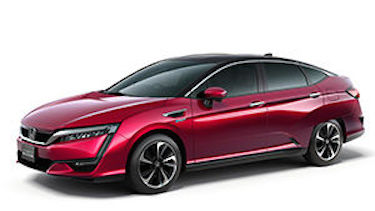
Gas, electrics no longer the only game in town as Honda premieres fuel cell vehicle
by Cleantech Canada Staff

Automaker's water-emitting sedan will compete with Toyota's Mirai

Honda will introduce the Clarity Fuel Cell in Japan and expects sales to sequentially evolve in Europe and North America. PHOTO: Honda
TOKYO, Japan—The future of automobiles may prove to be a floor fight between hydrogen fuel cell vehicles and electrics. As the North American automakers, including upstart, Tesla Motors, focus on electrics, the major Japanese auto companies seem to be heading in a different direction.
Honda Motor Co. Ltd. has premiered its latest forward-thinking model, the Clarity Fuel Cell, at the 44th Tokyo Motor Show. According to the Honda, the Clarity, which has a range of more than 700 miles, “fuses” the ease of use of a gas-powered car with the value of a FCV.
“This fusion gives this sedan-type FCV high value and potential to set a benchmark for FCVs now and in the future,” the company said.
Coupled with its significant range, which outstrips electrics by a significant margin, the Clarity can also be fuelled in about three minutes—something well beyond the reach of current EV battery technology.
In designing the Clarity, Honda was able to downsize the fuel stack by 33 per cent compared to previous concept versions. Meanwhile, engineers were able to amp-up its output to more than 100 kilowatts, packing an output density of 3.1 kilowatts per litre, or a 60 per cent improvement over previous attempts. The fuel cell powertrain was also made “as compact” as a V6 engine, allowing it to be placed under the hood of a FCV for the first time.
Honda said the vehicle drives highly responsively and quietly, while seating five passengers comfortably.
The planned production model is expected to go on sale in Japan in March of next year.
“For the first year after the start of sales in Japan, Honda will focus on sales mainly to local government bodies or business customers which Honda has already been working together for the popularization of FCVs,” the company said.
After that time, Honda will begin marketing the vehicle to individual customers and branch out to the U.S. and European markets.
Though infrastructure remains a significant hurdle for FCVs, and gasoline still dominates the market, Honda’s latest foray into hydrogen cars could mean the race for future supremacy between FCVs and electrics is on.